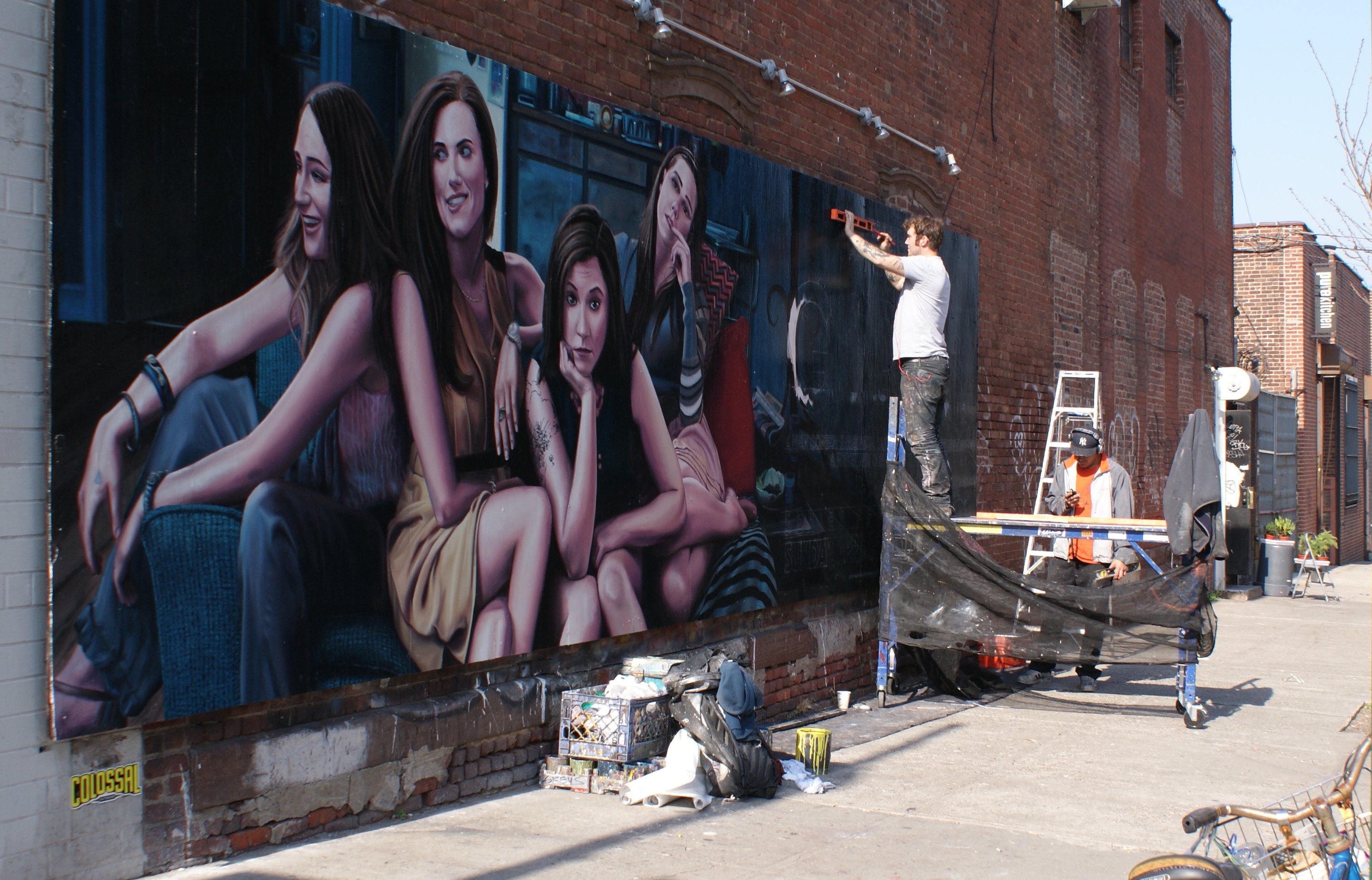The HBO series Girls — and its creator, writer, director, and star Lena Dunham — have attracted overwhelming media attention since the show first aired in 2012. Girls has received mixed reviews; some applaud the show and Lena Dunham, a self-proclaimed feminist, for bringing women’s issues to the forefront of social and political discourse, while others are disappointed with the show’s lack of diversity and its privileged characters. Whether positive or negative, it’s clear that Girls has had a profound impact on the contemporary feminist debate.
Girls follows the lives of four friends in their twenties navigating post-college life in New York City. Rather than depicting the lives of the main characters as glamorous, as does its HBO predecessor, Sex and the City, Girls paints an honest, unspectacular portrait of the lives of millennial women. Its characters are flawed, beyond the cliché of their inability to find love, and, despite being highly educated, constantly making poor choices. But this is actually a major strength of the show: viewers may not want to be like the characters, but they can relate to them.[1] This aligns with Dunham’s vision for Girls, as she feels women “have been waiting to see a reflection of somebody who feels a little more like someone they could know, or someone they could be.”[2]
Girls has stimulated extensive discourse on abortion. A powerful example takes place in season 4 when Adam’s new girlfriend Mimi-Rose gets an abortion without consulting him. She is calm and collected when she tells him about it, but Adam reacts poorly, knocking things over and yelling about how the decision should have involved him. It’s an interesting role swap, as we are used to seeing men being adamant and emotionless about getting an abortion, while the woman tends to be unsure and overwhelmed. Lena Dunham makes it clear that getting an abortion is a woman’s decision when Mimi-Rose calmly explains to Adam, “I didn’t want to talk about it beforehand; I just wanted to do it.” It was a simple decision for Mimi-Rose; she knew she wasn’t ready to have a child, so she terminated the pregnancy. In the episode’s commentary, Lena Dunham explained that rather than having the decision revolve around the stereotypical feelings of pain and angst, she wanted Mimi-Rose to be the complete opposite: calm and confident in her decision. Instead of playing into the common portrayal of women and abortion involving “tears and regret,” Lena sought to ensure that “abortion is without stigma and is not something that women feel like they have to apologize for.”[3] While some may not have appreciated the arguably blasé treatment of an important decision, the representation of abortion without emotional turmoil was refreshing and empowering to watch. Girls was able to create a meaningful dialogue around not only on the right to choose, but also the stigma surrounding abortion.
One of the most productive discourses surrounding Girls has been the show’s representation of women’s bodies. On other television shows, if a woman is naked, she is typically in peak physical shape, thin, wearing makeup, and under perfect lighting. This is not the case with Girls. Lena Dunham, who is frequently nude on the show, is not thin, doesn’t wear makeup, and seems to have no concern about whatever unflattering position she puts herself in.[4] Just seeing this contrast is striking and sparked a number of media conversations when the show premiered. The fact that we are surprised to see a “normal” body naked and having sex on television is a depressing testament to society’s ideas on beauty and how a woman’s body should look. The media is so saturated with images of women who have been photoshopped that it has become the status quo. The lack of representation of realistic female bodies in typical pop culture makes women with body types that do not fit the norms of “sexy,” “feminine,” or “beautiful” feel that they aren’t worthy of showing their bodies, since society only seems to accept nudity if it conforms to normative femininity and beauty. Girls challenges these norms by regularly featuring women like Lena Dunham naked and in an unglamorous way that de-sexualizes female nudity and refuses to appeal to male fantasies.[5]
Furthermore, the exclusion of women with imperfect bodies in popular culture suggests that physical perfection and beauty are the main qualities a woman must have to be attractive and find love. Girls challenges this through the romances and sexual encounters of Hannah. Despite not having a normative “sexy” body, the men in the show are still attracted to her.[6] Hannah has no trouble finding sexual partners, signifying that sexuality stems from more than physical appearance. This subversion of stereotypical ideas of attraction has caused backlash at times, especially in the second season when Hannah randomly meets a handsome doctor, played by Patrick Wilson, at the coffee shop where she works. After following him to his home to admit that she had been dumping the shop’s trash there, he spontaneously invites her in for what turns into two days of good food, ping-pong, and sex. The episode was followed by a media frenzy of critique from writers and viewers who could not fathom that a handsome, successful doctor could be attracted to Hannah, who is neither thin nor wealthy. Writers at Entertainment Weekly, Esquire, and Slate equated the episode’s plot to fantasy, with one critic saying it wasn’t believable because he couldn’t forget how attractive Patrick Wilson’s wife is.[7][8][9] The fact that multiple people share this view proves how vital it is that Girls continues pointing out the gender prejudices in our society. Girls’ representation of Hannah’s active sex life challenges the idea that beauty is the equivalent of having a “perfect” body. This representation is important in both creating a dialogue and building awareness of the more subtle, harmful cultural attitudes towards women’s bodies.
Girls is not purely for entertainment; it has a clear social and political agenda regarding society’s treatment of women and women’s issues. This partially explains the strong criticism aimed at the show and even Lena Dunham herself — if Girls is supposed to be feminist and help women, why does it feature an all-white cast that is privileged, college-educated, and middle-class? This is a fair critique, but it assumes that Girls should be an accurate representation of all women’s experiences. It would be impossible to embody that in a twenty-minute-a-week television show; in fact, a universal female experience is probably non-existent. In response to these concerns, Dunham explained that the show is a purposeful commentary on privilege and that it is meant to represent her own experiences, not the experiences of all women, which she is not able to speak to.
It may be because I am a white, middle-class, college-educated young woman, but I can see myself in the characters. Like Hannah, Marnie, Jessa, and Shoshanna, my friends and I struggle to figure out relationships, jobs, money, and identity. Girls not only represents an honest and unglamorous look at the lives of millennial women, but also challenges our culture’s attitudes toward women’s issues by stimulating feminist discourse. The show presents a unique take on abortion and forces its audience to reconsider its standards for beauty and the female body. With Girls, Lena Dunham embraces the idea that television isn’t just entertainment — it is art, social commentary, and political commentary.
[1] Meredith Nash and Ruby Grant, “Twenty-something Girls v. Thirty-Something Sex and the City Women: Paving the Way for ‘Post? Feminism’,” Feminist Media Studies (2015): 1-16.
[2] Lena Dunham, interview, Weekend All Things Considered, NPR, April 8, 2012.
[3] “Girls Season 4: Inside the Episode #6,” YouTube video, 04:00 Filmed [February 2015], posted by HBO, February 2015, https://www.youtube.com/watch?v=SP7rON6R5mc&feature=youtu.be&t=2m46s.
[4] Meredith Nash and Ruby Grant, “Twenty-something Girls v. Thirty-Something Sex and the City Women: Paving the Way for ‘Post? Feminism’,” Feminist Media Studies (2015): 1-16.
[5] Stefania Marghitu and Conrad Ng, “Body talk: Reconsidering the post-feminist discourse and critical reception of Lena Dunham’s girls,” Gender Forum (2013) 45 : 36 paragraphs.
[6] Stefania Marghitu and Conrad Ng, “Body talk: Reconsidering the post-feminist discourse and critical reception of Lena Dunham’s girls,” Gender Forum (2013) 45 : 36 paragraphs.
[7] Lindsey Bahr, “Girls recap: I Just Want To Be Happy,” Entertainment Weekly, February 11 2013, http://www.ew.com/recap/girls-season-2-episode-5?iid=sr-link1.
[8] Peter Martin, “The Girls Recap for Men: Self-Indulgent Dreaming,” Esquire, February 10, 2013, http://www.esquire.com/entertainment/tv/a19304/girls-season-2-episode-5-recap/.
[9] David Haglund and Daniel Engber, “Guys on Girls, Season 2,” Slate, February 2013, http://www.slate.com/articles/arts/tv_club/features/2013/girls_season_2/week_5/girls_on_hbo_one_man_s_trash_episode_5_of_season_2_reviewed_by_guys.html.



